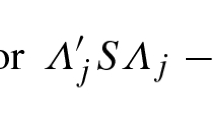Abstract
Previous results of the application of Lawley's selection theorem to the common factor analysis model are extended to a revision of Tucker's three-mode principal components model. If the regression of the three-mode manifest variates on variates used to select subpopulations is both linear and homoscedastic, the two factor pattern matrices, the core matrix, and the residual variance-covariance matrix in the three-mode model can all be assumed to be invariant across subpopulations. The implication of this finding for simple structure is discussed.
Similar content being viewed by others
References
Bellman, R. R.Introduction to matrix analysis. New York: McGraw-Hill, 1960.
Lawley, D. N. A note on Karl Pearson's selection formulae.Proceedings of the Royal Society of Edinburgh (Section A), 1943–44,62, 28–30.
Meredith, W. Notes on factorial invariance.Psychometrika, 1964,29, 177–185.
Thurstone, L. L.Multiple factor analysis. Chicago: University of Chicago Press, 1947.
Tucker, L. R. Implications of factor analysis of three-way matrices for measurement of change. In C. W. Harris (Ed.),Problems in measuring change. Madison: University of Wisconsin Press, 1963, 122–137.
Tucker, L. R. Some mathematical notes on three-mode factor analysis.Psychometrika, 1966,31, 279–311.
Author information
Authors and Affiliations
Rights and permissions
About this article
Cite this article
Bloxom, B. A note on invariance in three-mode factor analysis. Psychometrika 33, 347–350 (1968). https://doi.org/10.1007/BF02289329
Received:
Issue Date:
DOI: https://doi.org/10.1007/BF02289329




